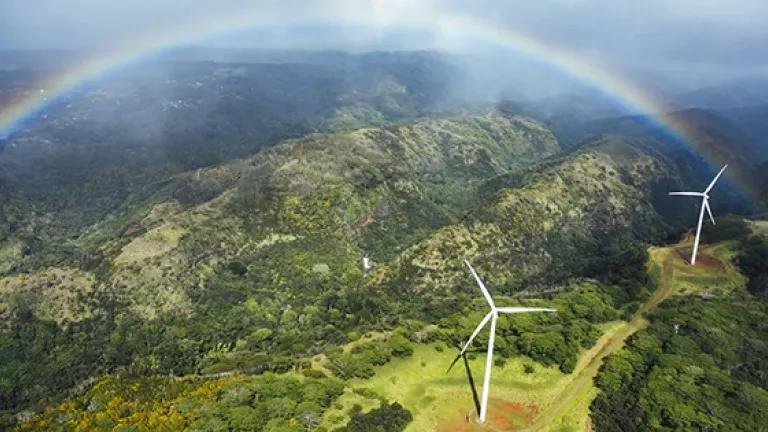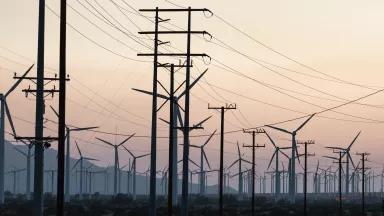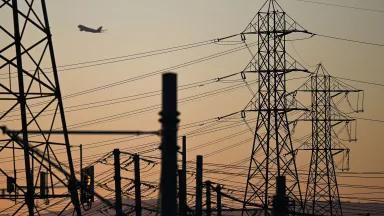Failing to Meet Our Climate Goals Is Not an Option
There’s more than one way the United States can nullify its climate emissions by 2050, but these strategies would make the journey a lot easier.

Wind and solar expansion is the cheapest way to quickly decarbonize the electricity grid. Here, solar panels are being installed in a Clean Energy Collective array at a community solar garden in Denver.
Kevin Moloney/The New York Times via Redux
As the world’s all-time top carbon emitter, the United States has some big decisions to make over the next 30 years. And the bottom line is non-negotiable: In order to stave off the most devastating and long-lasting impacts of climate change, the country must achieve net zero greenhouse gas emissions by 2050. There are numerous paths we can take to get us there, but together, certain strategies would cut climate pollution while also improving public health outcomes and fostering greater equity—all without blowing the bank. To that point, the savings from these action steps will quickly add up. NRDC estimates that we can deliver an average of about $9 billion a year in net energy system cost savings compared to doing nothing over the next three decades. By 2050, these savings increase to $35 billion a year. Below are a few tips on how the United States can get started—right now.
Clean up the grid
Ditching fossil fuels for renewable energy is the biggest and most cost-effective way the country can slash its greenhouse gas pollution this decade. Wind and solar power are already the cheapest sources of new electricity generation. Achieving net zero by 2050 would require generating 84 to 95 percent of the U.S. energy supply from renewable sources, up from about 20 percent today. While that may sound like pie in the sky, it’s not: The more than $369 billion slated for clean energy investment in the Inflation Reduction Act (IRA) could help build new renewable power projects at the speed and scale necessary, and the law’s $145 billion in clean energy tax credits has the potential to grow wind and solar generation up to 62 percent of the country’s electricity by 2030. To boot, the IRA’s 30 percent investment tax credit for the development of energy storage systems would help ensure that the surplus power generated on extra sunny or windy days doesn’t go to waste.
In the meantime, fossil fuel–burning power plants—the country’s second-largest source of climate pollution—can’t continue to send carbon pollution into the atmosphere at current rates. In the coming days, the U.S. Environmental Protection Agency plans to propose standards under the Clean Air Act that, together with IRA investments, could help the power sector cut its carbon emissions to 77 percent below 2005 levels over the next seven years.
Go electric
Having more renewable power on the grid is also essential for curbing the country’s biggest source of carbon pollution: transportation. A new NRDC report on the pathways to net zero states, “As more vehicles and buildings switch from fossil fuels to electricity, they will only be as clean as the grid powering them.” According to the International Council on Clean Transportation, the electric vehicles (EVs) on U.S. roads today are expected to emit 60 to 68 percent less climate pollution over their lifetime than their gasoline-burning counterparts. With more renewable power put into play, that gap only stands to widen.
Accordingly, the EV revolution is revving up to meet the challenge. Annual EV sales in the United States jumped 65 percent in 2022, and states across the country are committing to the rapid electrification of medium- and heavy-duty vehicles, which account for a quarter of the transportation sector’s current greenhouse gas emissions. California and New York, for example, both plan for all truck and bus sales to be emissions-free by 2045.
Electrifying household stoves and heaters, and implementing net zero building codes would also shrink our greenhouse gas output. A 2022 study found that, by replacing a gas furnace with an electric heat pump, the average home in the United States could potentially cut its carbon emissions up to 53 percent over the next 15 years. More immediately, it could also slash costs: The U.S. Department of Energy estimates that in contrast to conventional water heaters, a heat pump could cut electricity bills for a four-person household by $470 every year. Those savings would quickly offset the initial purchase of this technology, and new tax credits offered through the IRA would also bring the appliances into reach for more consumers.

Electric vehicles are inherently more efficient than gas-powered cars.
iStock
Efficiency, efficiency, efficiency
All this electrification is sure to increase demand for electricity, perhaps doubling or even quadrupling it by 2050. The good news is that energy efficiency measures can go a long way in helping us get more bang out of each kilowatt, giving us the power to keep the lights on without the need to, say, build more power plants. Buying more high-efficiency appliances, retrofitting old buildings, and requiring stronger efficiency codes for new structures are just some of the things we can do.
Improved energy efficiency is about how much electricity we consume as well as when we use it. Take EVs, for example. Owners can counteract demand by charging their cars at off-peak hours, or at times when strain on the grid is low. In a 2007 report out of the Pacific Northwest National Laboratory, researchers found that if EV charging is managed in this way, the country’s grid could have enough capacity to power a typical drive of 33 miles daily for nearly 200 million vehicles.
Equity, equity, equity
As we build new energy systems to fuel our daily activities, we must not only account for current social inequities but also take care to not create new ones. Since its very beginning, the fossil fuel regime has imposed disproportionately higher costs on members of low-income communities and communities of color in terms of health, longevity, prosperity, and quality of life. This is not a blueprint for the sustainable future we want to create. For instance, concentrating the installment of EV charging stations in more affluent areas could not only slow the widespread adoption of EVs but also keep the health benefits of lower tailpipe emissions from the neighborhoods that need them the most.
According to PSE Healthy Energy, a nonprofit research institute that looked into current decarbonization policies in three western states, the policies that center communities with heavy pollution burdens and high energy costs result in more significant public health and economic benefits than policies that focus solely on lowering emissions. What’s more, decarbonization policies that don’t account for equity could inadvertently prolong a community’s exposure to pollutants.
Most of the decarbonization plans in New Mexico, for instance, include the continued operations of natural gas plants for increased grid reliability. Such plants, however, tend to be in frontline communities already facing high cumulative risks from local industries. The report also found that due, in part, to a lack of access to financing, the state’s low-income households lag behind wealthier ones in decarbonization efforts like installing rooftop solar or replacing gas appliances with electric ones. As the number of gas customers declines overall, people who remain dependent on this fuel could face higher and higher energy bills in order to support the aging gas infrastructure. Considerations like these are why it’s crucial to incorporate equity into decarbonization strategies from the very start.

Forests across the world, such as the El Yunque National Forest in Puerto Rico here, are a critical natural carbon solution.
Preston Keres/USFS
Put the trees to work
Reaching net zero emissions by 2050 depends on how much climate pollution we emit as well as the environment’s ability to absorb and store carbon. Forests and wetlands are natural carbon sinks, and the more we keep intact—by protecting them from logging and development in the first place and by investing in reforestation and wetland restoration where needed—the slower carbon concentrations in the atmosphere will climb. Further, biodiversity and climate resilience go hand in hand and conserving at least 30 percent of land and oceans by 2030 (a global goal known as 30x30) would enhance them both simultaneously.
Sustainable farming also presents an opportunity to keep carbon out of our atmosphere through its storage in healthier soils and fewer emissions. (Conventional agriculture is responsible for 11 percent of U.S. greenhouse gas emissions.) Pesticide use, for instance, kills invertebrates that carry out underground activities critical to the soil’s ability to sequester carbon. Conversely, farming organically can boost soil health and crop strength, resulting in higher yields and carbon storage potential. Other soil-friendly practices that can help lower agriculture’s carbon footprint include planting cover crops and composting. They also decrease the need for fertilizers, which are often made from fossil fuels.
Don’t delay!
When it comes to fighting climate change, we know we need to make up for lost time. The United States spent around $165 billion dealing with climate-related disasters in 2022, from stronger hurricanes and severe droughts to longer, more destructive wildfire seasons. Delaying action would not only fuel the climate crisis with continued pollution but also make the later implementation of these strategies less coordinated and more expensive. According to NRDC’s net zero report, delaying action on electrification for 15 years would end up costing the United States another $1.3 trillion in energy expenditures over the next three decades. “By missing early opportunities to decarbonize,” it says, “the United States could land on a pathway with much higher system costs—billions of dollars that will be footed by American ratepayers and taxpayers.”
The report also presents several milestones for tracking progress, some of which are right around the corner. By the end of the decade, for example, at least 80 percent of the power sources feeding the grid should be renewable. Within the same time frame, all new appliances in buildings should be electric, and EVs should make up more than two-thirds of new light-duty vehicle sales.
These net zero strategies are more than suggestions. They are a compass to lead us out of the climate crisis we have unleashed. We must decarbonize and electrify. We must consume energy as efficiently as possible. We must protect our natural carbon traps and ourselves. We must center equity. The path to net zero is clear—the only question is whether we’ll run down it in time.
This NRDC.org story is available for online republication by news media outlets or nonprofits under these conditions: The writer(s) must be credited with a byline; you must note prominently that the story was originally published by NRDC.org and link to the original; the story cannot be edited (beyond simple things such as grammar); you can’t resell the story in any form or grant republishing rights to other outlets; you can’t republish our material wholesale or automatically—you need to select stories individually; you can’t republish the photos or graphics on our site without specific permission; you should drop us a note to let us know when you’ve used one of our stories.
We need climate action to be a top priority in Washington.
Tell President Biden and Congress to slash climate pollution and reduce our dependence on fossil fuels.

Urge President Biden and Congress to make equitable climate action a top priority
2023 was the hottest year on record, underscoring the urgency of shifting to clean energy and curbing the carbon pollution that is driving the climate crisis. President Biden and Congress have the tools to get the job done.













When Customers and Investors Demand Corporate Sustainability
What Are the Causes of Climate Change?
What Biden Should Get Done on Day One (or Close to It)
When Customers and Investors Demand Corporate Sustainability
What Are the Causes of Climate Change?
What Biden Should Get Done on Day One (or Close to It)
When Customers and Investors Demand Corporate Sustainability
What Are the Causes of Climate Change?
What Biden Should Get Done on Day One (or Close to It)
When Customers and Investors Demand Corporate Sustainability
What Are the Causes of Climate Change?